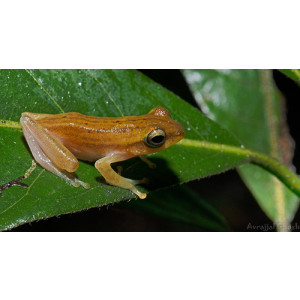@sullivanribbit

Twin-spotted Tree Frog Did you see this animal?
Scientific Name : Rhacophorus bipunctatus
Family : Rhacophoridae
Order : Anura
Class : Amphibia
Phylum : Chordata
Other Name : Twin-spotted Tree Frog, Two-spotted Tree Frog
Habitat : Nocturnal/Forests
Description : Twin-spotted Tree Frog is well-equipped for life in the trees. Its large, webbed feet with suction cups on the toes allow it to climb vertical surfaces, and its ability to glide using its extended toe membranes enables it to move between trees.
The species is usually green on its dorsal side, which helps it blend in with its surroundings in the tree canopy. The ventral side is usually yellowish or white, which also provides camouflage. The two black spots on its back behind the eyes are a distinguishing feature of this species.It can grow up to 7.5 cm in length.
it is a nocturnal species, which means that it is active at night. During the day, it hides in tree crevices, under leaves, or in other concealed locations to avoid predators. At night, it emerges to hunt for insects, such as crickets, flies, and moths.
Breeding typically occurs during the rainy season when the male calls to attract females. The female lays her eggs in a foam nest attached to vegetation overhanging a body of water, where they are protected from predators. The tadpoles hatch and drop into the water below, where they continue to develop until they metamorphose into froglets and are ready to live in the trees.
Rhacophorus bipunctatus is an important species in the ecosystem, as it serves as both predator and prey. Its diet consists of various insects, and it, in turn, is a food source for predators such as birds, snakes, and other reptiles.
However, like many species, Rhacophorus bipunctatus is facing threats from habitat loss and fragmentation due to human activities such as deforestation, agriculture, and urbanization. Climate change is also a potential threat, as it could alter the distribution and availability of suitable habitat. Conservation efforts are crucial to protect this and other species of frogs and toads, as they play an essential role in maintaining healthy ecosystems.
The species is usually green on its dorsal side, which helps it blend in with its surroundings in the tree canopy. The ventral side is usually yellowish or white, which also provides camouflage. The two black spots on its back behind the eyes are a distinguishing feature of this species.It can grow up to 7.5 cm in length.
it is a nocturnal species, which means that it is active at night. During the day, it hides in tree crevices, under leaves, or in other concealed locations to avoid predators. At night, it emerges to hunt for insects, such as crickets, flies, and moths.
Breeding typically occurs during the rainy season when the male calls to attract females. The female lays her eggs in a foam nest attached to vegetation overhanging a body of water, where they are protected from predators. The tadpoles hatch and drop into the water below, where they continue to develop until they metamorphose into froglets and are ready to live in the trees.
Rhacophorus bipunctatus is an important species in the ecosystem, as it serves as both predator and prey. Its diet consists of various insects, and it, in turn, is a food source for predators such as birds, snakes, and other reptiles.
However, like many species, Rhacophorus bipunctatus is facing threats from habitat loss and fragmentation due to human activities such as deforestation, agriculture, and urbanization. Climate change is also a potential threat, as it could alter the distribution and availability of suitable habitat. Conservation efforts are crucial to protect this and other species of frogs and toads, as they play an essential role in maintaining healthy ecosystems.
Distribution in Bangladesh
References:
description written by: Md. Shalauddin, Department of Zoology, Jagannath University, Dhaka. Information sources: IUCN Red List Bangladesh-2015, Hasan 2014, Khan 2018 (Photographic guide to the wildlife of Bangladesh).photo credit:sullivanribbit(www.inaturalist.org/people/sullivanribbit),photo copyright: iNaturalist. more information please contact with us.
description written by: Md. Shalauddin, Department of Zoology, Jagannath University, Dhaka. Information sources: IUCN Red List Bangladesh-2015, Hasan 2014, Khan 2018 (Photographic guide to the wildlife of Bangladesh).photo credit:sullivanribbit(www.inaturalist.org/people/sullivanribbit),photo copyright: iNaturalist. more information please contact with us.


















